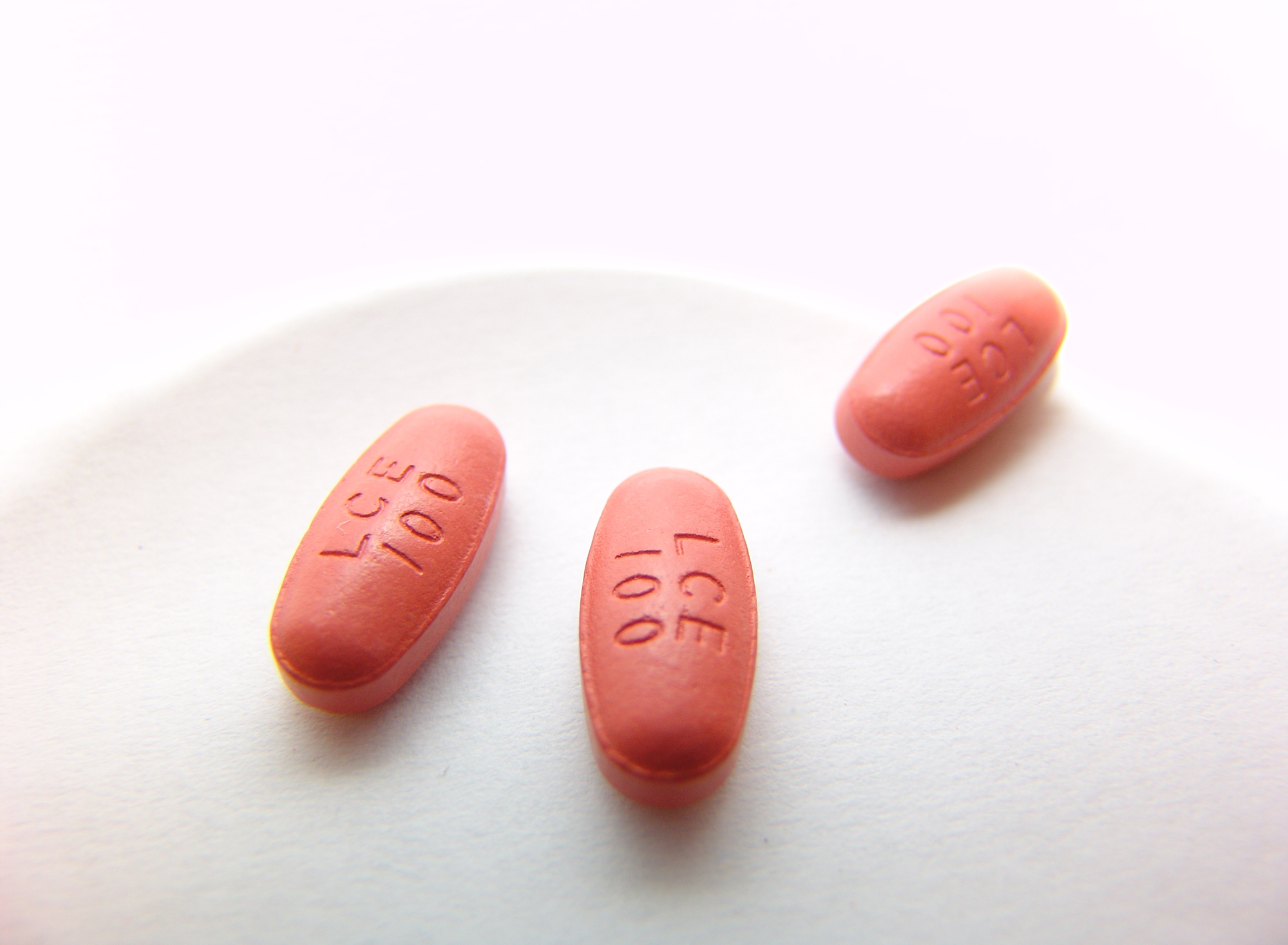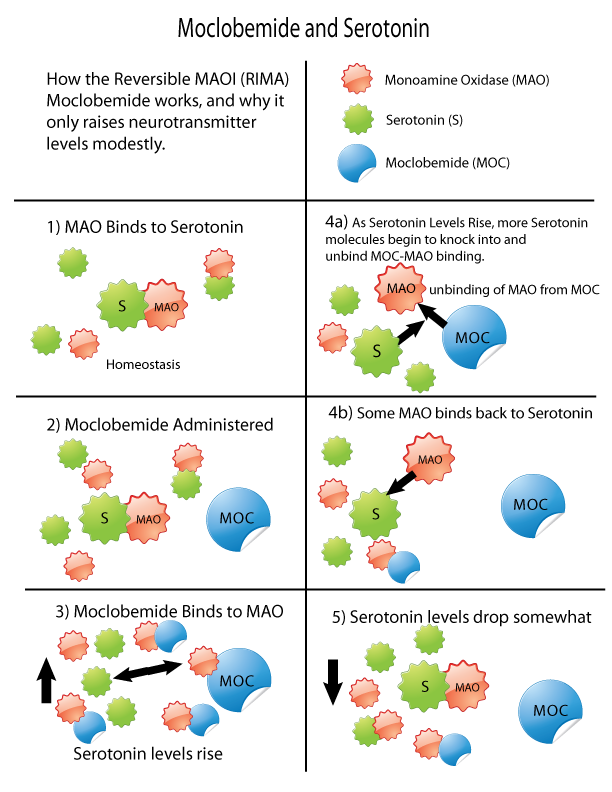|
Selegiline
Selegiline, also known as L-deprenyl and sold under the brand names Eldepryl, Zelapar, and Emsam among others, is a medication which is used in the treatment of Parkinson's disease and major depressive disorder. It has also been studied and used off-label for a variety of other indications, but has not been formally approved for any other use. The medication, in the form licensed for depression, has modest effectiveness for this condition that is similar to that of other antidepressants. Selegiline is provided as a swallowed tablet or capsule or an orally disintegrating tablet (ODT) for Parkinson's disease and as a patch applied to skin for depression. Side effects of selegiline occurring more often than with placebo include insomnia, dry mouth, dizziness, anxiety, abnormal dreams, and application site reactions (with the patch form), among others. At high doses, selegiline has the potential for dangerous food and drug interactions, such as tyramine-related hypertens ... [...More Info...] [...Related Items...] OR: [Wikipedia] [Google] [Baidu] |
Catecholaminergic Activity Enhancer
Monoaminergic activity enhancers (MAE), also known as catecholaminergic/serotonergic activity enhancers (CAE/SAE), are a class of drugs that enhance the action potential-evoked release of monoamine neurotransmitters in the nervous system. MAEs are distinct from monoamine releasing agents (MRAs) like amphetamine and fenfluramine in that they do not induce the release of monoamines from synaptic vesicles but rather potentiate only nerve impulse propagation-mediated monoamine release. That is, MAEs increase the amounts of monoamine neurotransmitters released by neurons per electrical impulse. MAEs have been shown to significantly enhance nerve impulse-mediated dopamine release in the striatum, substantia nigra, and olfactory tubercle; norepinephrine release from the locus coeruleus; and/or serotonin release from the raphe nucleus in rodent studies. Some MAEs are selective for effects on some of these neurotransmitters but not on others. The maximal impacts of MAEs on brain monoami ... [...More Info...] [...Related Items...] OR: [Wikipedia] [Google] [Baidu] |
Levoamphetamine
Levoamphetamine is a stimulant medication which is used in the treatment of certain medical conditions. It was previously marketed by itself under the brand name Cydril, but is now available only in combination drug, combination with dextroamphetamine in varying ratios under brand names like Adderall and Evekeo. The drug is known to increase wakefulness and attention, concentration in association with decreased appetite and Fatigue (medical), fatigue. Pharmaceuticals that contain levoamphetamine are currently indicated and prescribed for the treatment of attention deficit hyperactivity disorder (ADHD), obesity, and narcolepsy in some countries. Levoamphetamine is taken oral administration, by mouth. Levoamphetamine acts as a releasing agent of the monoamine neurotransmitters norepinephrine and dopamine. It is similar to dextroamphetamine in its ability to release norepinephrine and in its sympathomimetic effects but is a few times weaker than dextroamphetamine in its capacity ... [...More Info...] [...Related Items...] OR: [Wikipedia] [Google] [Baidu] |
Desmethylselegiline
Desmethylselegiline (DMS), also known as norselegiline or as ''N''-propargyl-L-amphetamine, is an active metabolite of selegiline, a medication used in the treatment of Parkinson's disease and depression. Like selegiline, DMS is a monoamine oxidase inhibitor (MAOI); specifically, it is a selective and irreversible inhibitor of monoamine oxidase B (MAO-B). In addition, it is a catecholaminergic activity enhancer (CAE) similarly to selegiline. The drug also produces levoamphetamine as an active metabolite, which is a norepinephrine–dopamine releasing agent with sympathomimetic and psychostimulant effects. DMS has been studied much less extensively than selegiline and has not been developed or approved for medical use. Pharmacology Pharmacodynamics DMS is a monoamine oxidase inhibitor (MAOI), similarly to selegiline. It is specifically a selective and irreversible inhibitor of monoamine oxidase B (MAO-B). The compound is also a catecholaminergic activity enhancer (CAE ... [...More Info...] [...Related Items...] OR: [Wikipedia] [Google] [Baidu] |
Antiparkinsonian Agent
In the management of Parkinson's disease, due to the chronic nature of Parkinson's disease (PD), a broad-based program is needed that includes patient and family education, support-group services, general wellness maintenance, exercise, and nutrition. At present, no cure for the disease is known, but medications or surgery can provide relief from the symptoms. While many medications treat Parkinson's, none actually reverses the effects of the disease. Furthermore, the gold-standard treatment varies with the disease state. People with Parkinson's, therefore, often must take a variety of medications to manage the disease's symptoms. Several medications currently in development seek to better address motor fluctuations and nonmotor symptoms of PD. However, none is yet on the market with specific approval to treat Parkinson's. Medication The main families of drugs useful for treating motor symptoms are levodopa, dopamine agonists, and MAO-B inhibitors. The most commonly used treatm ... [...More Info...] [...Related Items...] OR: [Wikipedia] [Google] [Baidu] |
Monoamine Oxidase Inhibitor
Monoamine oxidase inhibitors (MAOIs) are a drug class, class of drugs that inhibit the activity of one or both monoamine oxidase enzymes: monoamine oxidase A (MAO-A) and monoamine oxidase B (MAO-B). They are best known as effective antidepressants, especially for treatment-resistant depression and atypical depression. They are also used to treat panic disorder, social anxiety disorder, Parkinson's disease, and several other disorders. Reversible inhibitors of monoamine oxidase A (RIMAs) are a subclass of MAOIs that binding selectivity, selectively and Enzyme inhibitor#Reversible inhibitors, reversibly enzyme inhibitor, inhibit the MAO-A enzyme. RIMAs are used clinically in the medication, treatment of major depressive disorder, depression and dysthymia. Due to their reversibility, they are safer in single-drug overdose than the older, irreversible MAOIs, and weaker in increasing the monoamines important in depressive disorder. RIMAs have not gained widespread market share in th ... [...More Info...] [...Related Items...] OR: [Wikipedia] [Google] [Baidu] |
Levomethamphetamine
Levomethamphetamine (International Nonproprietary Name, INN: levmetamfetamine) is an optical isomer of methamphetamine primarily used as a Topical decongestant, topical nasal decongestant. Levomethamphetamine is used to treat nasal congestion from Allergic rhinitis, allergies and the common cold. It was first used medically as decongestant beginning in 1958 and has been used for such purposes, primarily in the United States, since then. Medical uses Levomethamphetamine is used to treat nasal congestion related to the common cold and allergic rhinitis. It is available in the form of an inhaler containing 50mg total per inhaler and delivering between 0.04 and 0.15mg of the drug per inhalation. Inhalers with a total of 113mg levomethamphetamine were previously marketed in the United States, but the total amount was eventually reduced to 50mg. Side effects When the nasal decongestant is taken in excess, levomethamphetamine has potential side effects. These would be similar to those ... [...More Info...] [...Related Items...] OR: [Wikipedia] [Google] [Baidu] |
Antidepressant
Antidepressants are a class of medications used to treat major depressive disorder, anxiety disorders, chronic pain, and addiction. Common side effects of antidepressants include Xerostomia, dry mouth, weight gain, dizziness, headaches, akathisia, sexual dysfunction, and emotional blunting. There is an increased risk of Suicidal ideation, suicidal thinking and Suicide, behavior when taken by children, adolescents, and young adults. Antidepressant discontinuation syndrome, Discontinuation syndrome, which resembles recurrent Depression (mood), depression in the case of the Selective serotonin reuptake inhibitor, SSRI class, may occur after stopping the intake of any antidepressant. Research regarding the effectiveness of antidepressants for depression in adults is controversial and has found both benefits and drawbacks. Meanwhile, evidence of benefit in children and adolescents is unclear, even though antidepressant use has considerably increased in children and adolescents in th ... [...More Info...] [...Related Items...] OR: [Wikipedia] [Google] [Baidu] |
Neuroprotective Agent
Neuroprotection refers to the relative preservation of neuronal structure and/or function. In the case of an ongoing insult (a neurodegenerative insult) the relative preservation of neuronal integrity implies a reduction in the rate of neuronal loss over time, which can be expressed as a differential equation. Mechanisms in neurodegeneration, and associated treatments It is a widely explored treatment option for many central nervous system disorders including neurodegenerative diseases, stroke, traumatic brain injury, spinal cord injury, and acute management of neurotoxin consumption (i.e. methamphetamine overdoses). Neuroprotection aims to prevent or slow disease progression and secondary injuries by halting or at least slowing the loss of neurons. Despite differences in symptoms or injuries associated with CNS disorders, many of the mechanisms behind neurodegeneration are the same. Common mechanisms of neuronal injury include decreased delivery of oxygen and glucose to the bra ... [...More Info...] [...Related Items...] OR: [Wikipedia] [Google] [Baidu] |
CYP2B6
Cytochrome P450 2B6 is an enzyme that in humans is encoded by the ''CYP2B6'' gene. CYP2B6 is a member of the cytochrome P450 group of enzymes. Along with CYP2A6, it is involved with metabolizing nicotine, along with many other substances. Function This gene, CYP2B6, encodes a member of the cytochrome P450 superfamily of enzymes. The cytochrome P450 proteins are monooxygenases which catalyze many reactions involved in drug metabolism and synthesis of cholesterol, steroids and other lipids. This protein localizes to the endoplasmic reticulum and its expression is induced by phenobarbital. The enzyme is known to metabolize some xenobiotics, such as the anti-cancer drugs cyclophosphamide and ifosphamide. Gene Transcript variants for this gene have been described; however, it has not been resolved whether these transcripts are in fact produced by this gene or by a closely related pseudogene Pseudogenes are nonfunctional segments of DNA that resemble functional genes. Pseudo ... [...More Info...] [...Related Items...] OR: [Wikipedia] [Google] [Baidu] |
Antidepressant
Antidepressants are a class of medications used to treat major depressive disorder, anxiety disorders, chronic pain, and addiction. Common side effects of antidepressants include Xerostomia, dry mouth, weight gain, dizziness, headaches, akathisia, sexual dysfunction, and emotional blunting. There is an increased risk of Suicidal ideation, suicidal thinking and Suicide, behavior when taken by children, adolescents, and young adults. Antidepressant discontinuation syndrome, Discontinuation syndrome, which resembles recurrent Depression (mood), depression in the case of the Selective serotonin reuptake inhibitor, SSRI class, may occur after stopping the intake of any antidepressant. Research regarding the effectiveness of antidepressants for depression in adults is controversial and has found both benefits and drawbacks. Meanwhile, evidence of benefit in children and adolescents is unclear, even though antidepressant use has considerably increased in children and adolescents in th ... [...More Info...] [...Related Items...] OR: [Wikipedia] [Google] [Baidu] |
Off-label Use
Off-label use is the use of pharmaceutical drugs for an unapproved indication or in an unapproved age group, dosage, or route of administration. Both prescription drugs and over-the-counter drugs (OTCs) can be used in off-label ways, although most studies of off-label use focus on prescription drugs. Off-label use is very common and generally legal unless it violates ethical guidelines or safety regulations. The ability to prescribe drugs for uses beyond the officially approved indications is commonly used to good effect by healthcare providers. For example, methotrexate is commonly used off-label because its immunomodulatory effects relieve various disorders. However, off-label use can entail health risks and differences in legal liability. Marketing of pharmaceuticals for off-label use is usually prohibited. Indications and labeling laws An '' indication'' is when a drug is medically appropriate for a given condition; an approved indication is when a government drug regula ... [...More Info...] [...Related Items...] OR: [Wikipedia] [Google] [Baidu] |
Major Depressive Disorder
Major depressive disorder (MDD), also known as clinical depression, is a mental disorder characterized by at least two weeks of pervasive depression (mood), low mood, low self-esteem, and anhedonia, loss of interest or pleasure in normally enjoyable activities. Introduced by a group of US clinicians in the mid-1970s, the term was adopted by the American Psychiatric Association for this syndrome, symptom cluster under mood disorders in the 1980 version of the ''Diagnostic and Statistical Manual of Mental Disorders'' (DSM-III), and has become widely used since. The disorder causes the second-most years lived with disability, after low back pain, lower back pain. The diagnosis of major depressive disorder is based on the person's reported experiences, behavior reported by family or friends, and a mental status examination. There is no laboratory test for the disorder, but testing may be done to rule out physical conditions that can cause similar symptoms. The most common time o ... [...More Info...] [...Related Items...] OR: [Wikipedia] [Google] [Baidu] |




